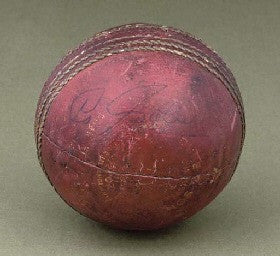The past several years have seen something of a revival in interest in the cricket rivalry between England and Australia as the Ashes have become more competitive once again from 2005 onwards.
The rivalry is the most famous in cricket and dates back to 1882 when England lost a match to Australia on English ground for the first time (at the Oval) and a spoof obituary for English cricket suggesting that "the body will be cremated and the ashes taken to Australia".
As the series gets underway with England already slightly on the back foot (although this allows for a variety of cross-batted pulls, hooks and cuts through gully...), we thought it would be a great time to look at our favourite five pieces of cricket memorabilia.
The medal from the dawn of cricket
It seems appropriate start with a medal related to the very first test match, which took place between England and Australia in 1877 in Melbourne, long before the series was dubbed the Ashes. Specifically it was a gold medal presented to the English cricketer Harry Charlwood.
 Charlwood gold cricket medal |
The obverse is engraved with crossed cricket bats, stumps and a ball, whilst the reverse shows the engraved words for Charlwood: "presented to, H. Charlwood, by, GE0. Browne C.E., architect, M.C.C. grand stand, Melbourne, 1877".
Charlwood only played two test matches himself in a long cricket career in which he was noted for his attacking batting and specialist fielding at cover. The medal went under the hammer at Graham Budd auctioneers earlier this month and sold as expected for £10,000.
The ball battered by King Cricket
West Indian captain Garfield 'Gary' Sobers is regarded as one of the greatest all-rounders in the history of the game, showing true excellence as batsman, bowler and fielder alike.
His most famous moment however was not in a test match but captain of Nottinghamshire against Glamorgan in Swansea when he was the first batsman to score six sixes (the maximum score usually possible from a single ball by hitting it clean over the boundary rope without it touching the field) in a six ball over.
 Gary Sobers's six sixes ball |
The unlucky bowler, Malcolm Nash, actually used three balls in the pasting as the first two took too long to return to the pitch. The ball which took most of the punishment - four of the six shots - was signed by 'King Cricket' Sobers and sold at Christie's in 2006.
It once again smashed over the boundary of its upper estimate of £8,000, being caught by a bidder for a more fitting £26,400. Even at this price it makes an exceptional investment.
The Little Master's Bat
Sachin Tendulkar is regarded as India's greatest batsman of all time and one of the greatest ever, having scored more test match runs than any other player in history (currently 14366 at an average of 56.6).
He is so revered that his success story has been made a textbook lesson in Indian schools.
Last month, a charity auction saw one of the 'Little Master's' bats, with which he scored 163 not out against New Zealand at Christchurch in 2009, sold for Rs 42 lakh ($93,619) - a reminder of the strength of the Indian collectibles market in general and the Indian love of cricket in particular.
The Gospel according to Wisden
John Wisden was a respected all-rounder in county cricket who played for three teams in the middle of the 19th century. His main contribution to cricket, however, was offered after he finished playing: There are many 'gods of cricket' worshipped around the world, but only one 'bible': Wisden's Almanack.
Regarded as the most famous sports reference book it covers controversies, notes statistics and gives coveted awards to outstanding players of the world. Some of the early editions are distinctly rare, especially in good condition.
 Wisden cricket almanacks |
In 2009, Bonhams offered an extraordinary collection: a complete run of the Wisden Cricketers' Almanack for the years 1864 to 1984, handsomely bound and in fine condition.
It was the surprise top lot in this sale, driven past its estimate of £50,000-70,000 to a stunning £90,000 ($142,000).
The Don's Baggy Green
Donald Bradman (pictured) is regarded by most as hands-down the best batsman in cricketing history, and Australians cite him as their favourite person in the country's history, never mind cricketer.
Famously denied an average of 100 by being out for a duck (0) in his last match, when a very low score would have sufficed for the man used to smashing centuries, 'The Don's' average of 99.94 still looks like a mistake in lists where no batsman retains an average over 60 for long.
Bradman's 'Baggy Green' - the cap that marks out an Aussie test player, worn in that 1948 match was given to the son of English friend Richard Robins after he saw Robins's son playing cricket in his backyard with a makeshift cap.
The Don said, 'We can't have that, we'd better get you a decent one one', and a short while later in the mail the 1948 baggy green arrived.
A unique piece from a legendary moment in cricketing history, it was sold in 2003 for A$420,000 ($282,000).
- Learn how you can get pleasure and profit by investing in rare sports memorabilia
- Click here for all the latest Autographs and Memorabilia news
Join our readers in over 200 countries around the world - sign up for your free weekly Collectibles Newsletter today






